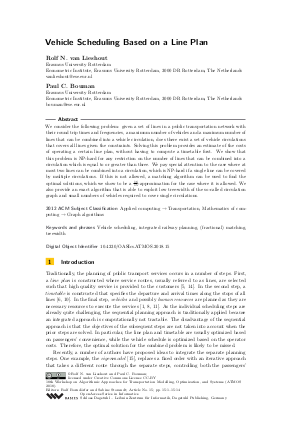Vehicle Scheduling Based on a Line Plan
Authors Rolf N. van Lieshout, Paul C. Bouman
-
Part of:
Volume:
18th Workshop on Algorithmic Approaches for Transportation Modelling, Optimization, and Systems (ATMOS 2018)
Part of: Series: Open Access Series in Informatics (OASIcs)
Part of: Conference: Symposium on Algorithmic Approaches for Transportation Modelling, Optimization, and Systems (ATMOS) - License:
 Creative Commons Attribution 3.0 Unported license
Creative Commons Attribution 3.0 Unported license
- Publication Date: 2018-08-28
File

PDF
OASIcs.ATMOS.2018.15.pdf
- Filesize: 0.59 MB
- 14 pages
Document Identifiers
Subject Classification
ACM Subject Classification
- Applied computing → Transportation
- Mathematics of computing → Graph algorithms
Keywords
- Vehicle scheduling
- integrated railway planning
- (fractional) matching
- treewidth
Metrics
- Access Statistics
-
Total Accesses (updated on a weekly basis)
0Document
0Metadata
Abstract
We consider the following problem: given a set of lines in a public transportation network with their round trip times and frequencies, a maximum number of vehicles and a maximum number of lines that can be combined into a vehicle circulation, does there exist a set of vehicle circulations that covers all lines given the constraints. Solving this problem provides an estimate of the costs of operating a certain line plan, without having to compute a timetable first. We show that this problem is NP-hard for any restriction on the number of lines that can be combined into a circulation which is equal to or greater than three. We pay special attention to the case where at most two lines can be combined into a circulation, which is NP-hard if a single line can be covered by multiple circulations. If this is not allowed, a matching algorithm can be used to find the optimal solutions, which we show to be a 16/15-approximation for the case where it is allowed. We also provide an exact algorithm that is able to exploit low tree-width of the so-called circulation graph and small numbers of vehicles required to cover single circulations.
Cite As Get BibTex
Rolf N. van Lieshout and Paul C. Bouman. Vehicle Scheduling Based on a Line Plan. In 18th Workshop on Algorithmic Approaches for Transportation Modelling, Optimization, and Systems (ATMOS 2018). Open Access Series in Informatics (OASIcs), Volume 65, pp. 15:1-15:14, Schloss Dagstuhl – Leibniz-Zentrum für Informatik (2018)
https://doi.org/10.4230/OASIcs.ATMOS.2018.15
BibTex
@InProceedings{vanlieshout_et_al:OASIcs.ATMOS.2018.15,
author = {van Lieshout, Rolf N. and Bouman, Paul C.},
title = {{Vehicle Scheduling Based on a Line Plan}},
booktitle = {18th Workshop on Algorithmic Approaches for Transportation Modelling, Optimization, and Systems (ATMOS 2018)},
pages = {15:1--15:14},
series = {Open Access Series in Informatics (OASIcs)},
ISBN = {978-3-95977-096-5},
ISSN = {2190-6807},
year = {2018},
volume = {65},
editor = {Bornd\"{o}rfer, Ralf and Storandt, Sabine},
publisher = {Schloss Dagstuhl -- Leibniz-Zentrum f{\"u}r Informatik},
address = {Dagstuhl, Germany},
URL = {https://drops.dagstuhl.de/entities/document/10.4230/OASIcs.ATMOS.2018.15},
URN = {urn:nbn:de:0030-drops-97204},
doi = {10.4230/OASIcs.ATMOS.2018.15},
annote = {Keywords: Vehicle scheduling, integrated railway planning, (fractional) matching, treewidth}
}
Author Details
- Erasmus University Rotterdam, Econometric Institute, Erasmus University Rotterdam, 3000 DR Rotterdam, The Netherlands
References
-
Erwin JW Abbink, Luis Albino, Twan Dollevoet, Dennis Huisman, Jorge Roussado, and Ricardo L Saldanha. Solving large scale crew scheduling problems in practice. Public Transport, 3(2):149-164, 2011.

-
Michel Louis Balinski. Integer programming: methods, uses, computations. Management science, 12(3):253-313, 1965.

-
Hans L Bodlaender. A linear-time algorithm for finding tree-decompositions of small treewidth. SIAM Journal on computing, 25(6):1305-1317, 1996.

-
Hans L Bodlaender and Ton Kloks. Efficient and constructive algorithms for the pathwidth and treewidth of graphs. Journal of Algorithms, 21(2):358-402, 1996.

-
Ralf Borndörfer, Martin Grötschel, and Marc E Pfetsch. A column-generation approach to line planning in public transport. Transportation Science, 41(1):123-132, 2007.

-
Gabrio Caimi, Leo Kroon, and Christian Liebchen. Models for railway timetable optimization: Applicability and applications in practice. Journal of Rail Transport Planning &Management, 6(4):285-312, 2017.

-
Ilkyoo Choi, Jaehoon Kim, and O Suil. The difference and ratio of the fractional matching number and the matching number of graphs. Discrete Mathematics, 339(4):1382-1386, 2016.

-
Pieter-Jan Fioole, Leo Kroon, Gábor Maróti, and Alexander Schrijver. A rolling stock circulation model for combining and splitting of passenger trains. European Journal of Operational Research, 174(2):1281-1297, 2006.

-
Michael R Garey and David S Johnson. Computers and intractability. a guide to the theory of NP-completeness. a series of books in the mathematical sciences, 1979.

-
Omar J Ibarra-Rojas, Fernando López-Irarragorri, and Yasmin A Rios-Solis. Multiperiod bus timetabling. Transportation Science, 50(3):805-822, 2015.

-
Natalia Kliewer, Bastian Amberg, and Boris Amberg. Multiple depot vehicle and crew scheduling with time windows for scheduled trips. Public Transport, 3(3):213-244, 2012.

- Julius Pätzold, Alexander Schiewe, Philine Schiewe, and Anita Schöbel. Look-Ahead Approaches for Integrated Planning in Public Transportation. In Gianlorenzo D'Angelo and Twan Dollevoet, editors, 17th Workshop on Algorithmic Approaches for Transportation Modelling, Optimization, and Systems (ATMOS 2017), volume 59 of OpenAccess Series in Informatics (OASIcs), pages 17:1-17:16, Dagstuhl, Germany, 2017. Schloss Dagstuhl-Leibniz-Zentrum fuer Informatik. URL: http://dx.doi.org/10.4230/OASIcs.ATMOS.2017.17.
-
Neil Robertson and Paul D. Seymour. Graph minors. ii. algorithmic aspects of tree-width. Journal of algorithms, 7(3):309-322, 1986.

-
Anita Schöbel. Line planning in public transportation: models and methods. OR spectrum, 34(3):491-510, 2012.

-
Anita Schöbel. An eigenmodel for iterative line planning, timetabling and vehicle scheduling in public transportation. Transportation Research Part C: Emerging Technologies, 74:348-365, 2017.

- Hisao Tamaki. Positive-Instance Driven Dynamic Programming for Treewidth. In Kirk Pruhs and Christian Sohler, editors, 25th Annual European Symposium on Algorithms (ESA 2017), volume 87 of Leibniz International Proceedings in Informatics (LIPIcs), pages 68:1-68:13, Dagstuhl, Germany, 2017. Schloss Dagstuhl-Leibniz-Zentrum fuer Informatik. URL: http://dx.doi.org/10.4230/LIPIcs.ESA.2017.68.
